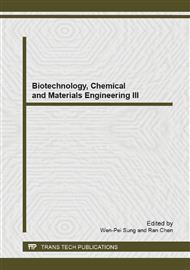[1]
A.P. Zeng, W Sabra (2011) Microbial production of diols as platform chemicals: Recent progresses. Current Opinion in Biotechnology 22 (6): 749-757.
DOI: 10.1016/j.copbio.2011.05.005
Google Scholar
[2]
A.K. Ringel, E. Wilkens, D. Hortig, et al (2012) An improved screening method for microorganisms able to convert crude glycerol to 1, 3-propanediol and to tolerate high product concentrations. Appl Microbiol Biotechnol 93 (3): 1049-1056.
DOI: 10.1007/s00253-011-3594-7
Google Scholar
[3]
P. Anand, R.K. Saxena (2012) A novel thin-layer chromatography method to screen 1, 3-propanediol producers. J Ind Microbiol Biotechnol 39 (11): 1713-1718.
DOI: 10.1007/s10295-012-1161-6
Google Scholar
[4]
E. Celinska (2010) Debottlenecking the 1, 3-propanediol pathway by metabolic engineering. Biotechnol Adv 28 (4): 519-530.
Google Scholar
[5]
P.F. Tian, T.W. Tan (2007) [Progress in metabolism and crucial enzymes of glycerol conversion to 1, 3-propanediol]. Sheng Wu Gong Cheng Xue Bao 23 (2): 201-205.
Google Scholar
[6]
R.K. Saxena, P. Anand, S. Saran, J. Isar (2009) Microbial production of 1, 3-propanediol: Recent developments and emerging opportunities. Biotechnol Adv 27 (6): 895-913.
DOI: 10.1016/j.biotechadv.2009.07.003
Google Scholar
[7]
J. Sambrook(2001)Molecular cloning. Cold Spring Harbor Laboratory, Cold Spring Harbor, N. Y.
DOI: 10.5962/bhl.title.49161
Google Scholar
[8]
V. Gurtler, V.A. Stanisich (1996) New approaches to typing and identification of bacteria using the 16S-23S rDNA spacer region. Microbiology 142 ( Pt 1): 3-16.
DOI: 10.1099/13500872-142-1-3
Google Scholar
[9]
J. Zhang, T.L. Madden (1997) PowerBLAST: a new network BLAST application for interactive or automated sequence analysis and annotation. Genome Res 7 (6): 649-656.
DOI: 10.1101/gr.7.6.649
Google Scholar
[10]
K. Tamura, D. Peterson, N. Peterson, et al(2011) MEGA5: molecular evolutionary genetics analysis using maximum likelihood, evolutionary distance, and maximum parsimony methods. Mol Biol Evol 28 (10): 2731-2739.
DOI: 10.1093/molbev/msr121
Google Scholar
[11]
H. Qin, H. Yang, Z. Qiao, et al(2013)Identification and characterization of a Bacillus subtilis strain HB-1 isolated from Yandou, a fermented soybean food in China. Food Control 31(1): 22-27.
DOI: 10.1016/j.foodcont.2012.10.004
Google Scholar
[12]
T. Homann, C. Tag, H. Biebl, et al (1990) Fermentation of glycerol to 1, 3-propanediol by Klebsiella and Citrobacter strains. Appl Microbiol Biotechnol 33 (2): 121-126.
DOI: 10.1007/bf00176511
Google Scholar
[13]
J. Hao, R. Lin, Z. Zheng, H. Liu, D. Liu (2008) Isolation and characterization of microorganisms able to produce 1, 3-propanediol under aerobic conditions. World J Microbiol Biotechnol 24 (9): 1731-1740.
DOI: 10.1007/s11274-008-9665-y
Google Scholar
[14]
H. Malaoui, R. Marczak (2001) Influence of glucose on glycerol metabolism by wild-type and mutant strains of Clostridium butyricum E5 grown in chemostat culture. Appl Microbiol Biotechnol 55 (2): 226-233.
DOI: 10.1007/s002530000495
Google Scholar
[15]
E.A. Johnson, R.L. Levine, E.C. Lin (1985) Inactivation of glycerol dehydrogenase of Klebsiella pneumoniae and the role of divalent cations. J Bacteriol 164 (1): 479-483.
DOI: 10.1128/jb.164.1.479-483.1985
Google Scholar
[16]
M. Chevalier, E.C. Lin, R.L. Levine (1990) Hydrogen peroxide mediates the oxidative inactivation of enzymes following the switch from anaerobic to aerobic metabolism in Klebsiella pneumoniae. J Biol Chem 265 (1): 42-46.
DOI: 10.1016/s0021-9258(19)40191-9
Google Scholar
[17]
H.J. Liu, D.J. Zhang, Y.H. Xu, et al (2007) Microbial production of 1, 3-propanediol from glycerol by Klebsiella pneumoniae under micro-aerobic conditions up to a pilot scale. Biotechnol Lett 29 (8): 1281-1285.
DOI: 10.1007/s10529-007-9398-2
Google Scholar
[18]
F. Barbirato, J.P. Grivet, P. Soucaille, A. Bories (1996) 3-Hydroxypropionaldehyde, an inhibitory metabolite of glycerol fermentation to 1, 3-propanediol by enterobacterial species. Appl Environ Microbiol 62 (4): 1448-1451.
DOI: 10.1128/aem.62.4.1448-1451.1996
Google Scholar
[19]
Z.M. Zheng, K.K. Cheng, Q.L. Hu, et al (2008) Effect of culture conditions on 3-hydroxypropionaldehyde detoxification in 1, 3-propanediol fermentation by Klebsiella pneumoniae. Biochemical Engineering Journal 39 (2): 305-310.
DOI: 10.1016/j.bej.2007.10.001
Google Scholar
[20]
M. Metsoviti, A.P. Zeng, A.A. Koutinas, S. Papanikolaou (2013).
Google Scholar


